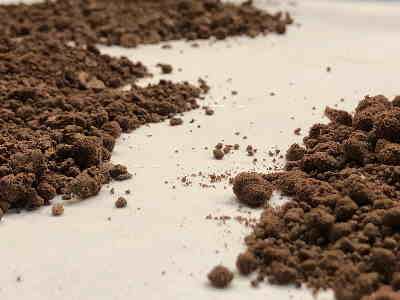Size enlargement operations are used in the powder processing industry with different purposes, such as improving handling and flow, reducing losses, producing specific shapes, reducing dust, improving product uniformity, boosting the appearance, and so on. There are several size enlargement processes named as compaction, granulation, encapsulation, pelletizing and agglomeration. Some of these terms may represent the same operation but they are typically applied in different types of industries.
Two main categories of size enlargement are:
1) Processes that aim to control the functional properties such as granulation.
2) Processes that target the production of defined forms such as tablets and pellets.
In order to control/change the functional properties of solids, we apply a size enlargement process as granulation, also named as tumbling agglomeration. Granulation transforms a powder material into larger entities, to end up with an aggregate considerably larger in size and with a porous structure. The basic granulation method is called tumble/growth size enlargement method, which produces agglomerates of approximately spherical shape by build-up of fine particulate solids during tumbling. Such resulting granules are often weak and require binder material to facilitate their formation and to reach a decent final strength. These larger granules are more free flowing and display less dust compared to the parent powder materials. Moreover, the granular matter is typically easier to handle and display easy dosing. Granulation also avoids segregation of powder mixtures since the individual particles of different composition cannot freely move around anymore. In tumbling granulation/agglomeration, an important factor in the operation is the quantity of binder liquid, named as the binder, to add into the process in order to obtain resistant and functional agglomerates. On the other hand, the rotation speed of the granulation unit is also crucial. An optimal rotation speed should guarantee sufficient time to promote particle-particle interaction and facilitate the size enlargement process.
Granulation processes
Granulation processes have been used to solve dustiness issues in many industries. In the food industry, granules with open structure can create optimal dispersion characteristics for many fine food powders, leading to instant products.
During granulation in a disc pelletizer, hardly any shear forces are applied to the sample materials and therefore the granules display a rather open structure. These granules have typical properties like a low mechanical strength, more shape flexibility, and less pressure drop. In contrast, the application of high-shear granulation experiments results in more dense granules with clearly different properties. So depending on the requirements, specific properties such as granule size, porosity, hardness, etc. can be donated to the granules for optimal performance in the desired application, such as instant products. Our high-shear granulation equipment is also equipped with a high-accuracy dosing system for dispersing the binder liquid in a good manner to achieve high-quality granules with uniform properties.
On the other hand, a rather different size enlargement method exists called Pressure agglomeration, also known as tabletting. The products from the pressure agglomeration can reach certain demanded size. Often they can be formed without the need of binder material and acquire immediate strength, this is a consequence of plastic deformation. Pressure agglomeration processes can be used for the purposes on easier handling, easier consumption and controlled release in food, pharmaceutical and agricultural industries. It can reduce the stickiness if the products are in tablet form. It can be also used as the pre-treatment for some analytical measurement such as SEM (Scanning Electron Microscopy).
Different granulation and pressure agglomeration set-ups are available in our field testing area. Granulation can be executed by high shear granulation equipment, low shear rotating drums and low shear disc pelletizer. Pressure agglomeration can be executed by means of various hydraulic presses and different tabletting moulds.
After the size enlargement process, several analytical measurements such as helium pycnometry, mercury porosimetry and gas physisorption can be used to determine the density and porosity of the resulting granules and tablets. Meanwhile, the tablet hardness tester and rotating drum can be applied the granules/tablets strength and loss on attrition.




